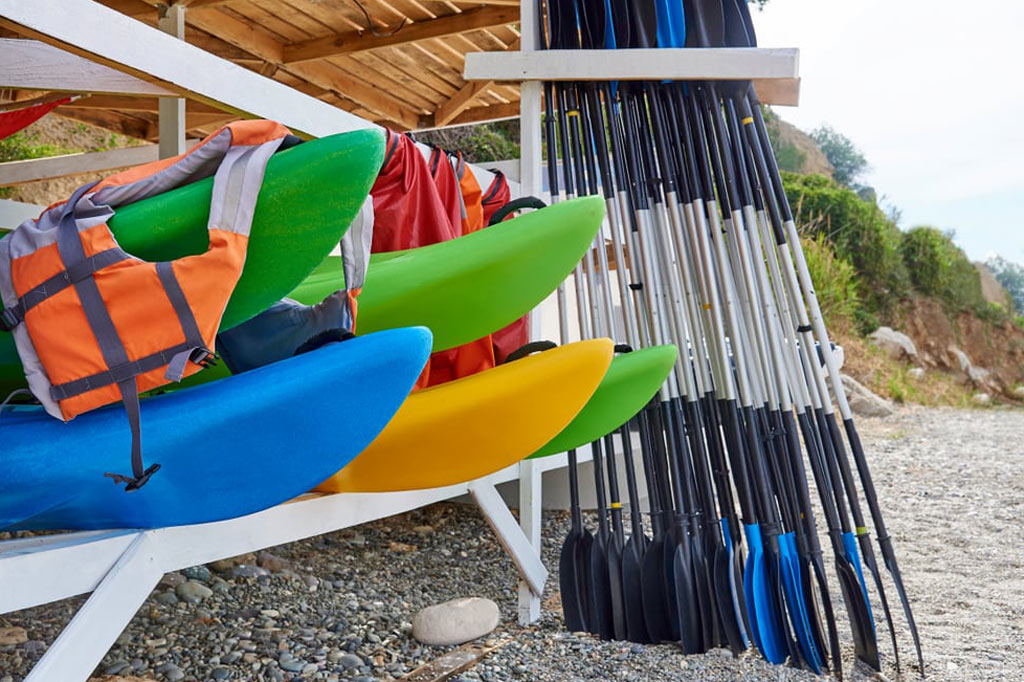Fall is upon us, and winter is just around the corner. The rivers are low, the temperatures have dropped, and birds are heading south. You know what that means: it’s time to winterize your kayak or boat.
When it gets too chilly for river trips, most of us turn our attention toward getting ready for the winter season: chopping firewood, buying ski passes, and bringing the lawn furniture inside. What many people don’t think about, though, is how to protect their summer toys from winter weather.
Just like your motorboat, RV, or camper requires winterization, so, too, does your kayak or raft. In this post, we’ll walk you through the process of putting these things to bed for the winter, so they’re ready to go out and play next spring.
Let’s get started.
Why Winterize Your Kayak or Raft?
Kayaks and rafts are durable, but a frigid winter takes a toll on even the most robust material. By winterizing your boats, you’re protecting their longevity and ensuring they’re ready to use again next spring when the world warms up once more.
Here’s what can happen without proper winterization:
- Freezing temperatures make plastic, fiberglass, and rubber brittle and weak
- Moisture buildup expands when frozen, causing cracks and warped seals
- UV damage from winter sun accelerates fading and cracking
- Rodents look for cozy nesting spots in stored equipment
- Material breakdown shortens your boat’s lifespan significantly
The good news? Winterizing your kayak or raft is simple and can be done in an afternoon.
Complete Kayak & Hard Paddleboard Winterization Checklist
Winterizing a kayak or paddleboard is a simple process, and can quickly be done in an afternoon. Follow these tips:
- Check all rigging. Look for bungee cords that are losing their elasticity or whose ends are fraying. Check the kayak’s deck for UV damage or hardware issues, and replace parts, if necessary. Replace worn components before storage (much easier than spring repairs)
- Clean the cockpit. Remove the kayak seat and use a hose and a damp rag to clean out any gunk that’s built up. Allow the kayak to dry completely (24-48 hours) before storage to prevent mold and mildew
- Inspect the hull. Look for dings, scratches, and holes that could impact your paddling. If your boat has deep scratches, take it in for repair before you put it away for the season. Important: Address significant damage now. Spring repair shops get backed up quickly, and you don’t want to miss early season paddling.
- Store the boat somewhere dry. A garage or shed is ideal for kayak storage, as it keeps the kayak out of the elements until you’re ready to use it again. Be sure to store the kayak up off the ground to avoid rodent nesting.
How to Winterize Your Raft or Inflatable Paddleboard
While kayaks are made of fiberglass, most rafts and inflatable paddleboards are coated in synthetic rubber, PVC, or urethane. Here’s how to protect your inflatable boat from the winter weather:
- Clean the surface. Before the weather gets frigid, wash the raft with water and inflatable boat cleaner. Let the cleaner sit for about 60 seconds, and then scrub with a gentle brush or sponge. Clean the floor and tubes thoroughly.
- Clean the underside. Take the frame off your raft (if applicable) and flip it over, still fully inflated. Inspect the bottom of the boat for damage or scrim shots. Protect weak spots with Gear Aid Aquaseal Repair Adhesive. Repeat the cleaning process on the underside. Finish by coating the entire boat, top, and bottom, with a UV protectant. We like 303 Aerospace Protectant. This is a premium surface treatment that provides superior protection against harmful UV rays that can cause discoloration, fading, cracking, and chalking. Treated surfaces repel dirt, soiling, staining, water spots, salt water, mildew. 303 is very helpful to prolong the lifetime of your raft.
- Deflate the boat. Store it by rolling it up and keeping it inside. If you prefer not to completely deflate it, leave your raft, cataraft, or inflatable kayak softly inflated. Store it inside (in a garage is ideal) and out of direct sunlight.
Common Winterization Mistakes to Avoid
- Storing wet equipment: Always allow complete drying to prevent mold
- Using plastic tarps: These trap moisture; use breathable covers instead
- Leaving in direct sunlight: UV damage continues year-round
- Storing deflated boats compressed: This creates permanent creases
- Forgetting to remove batteries: Take out fish finder and light batteries to prevent corrosion
Ready for An Adventure in West Glacier?
Proper winterization is the difference between a kayak or raft that lasts 5 years versus 15 years. By investing a few hours each fall, you ensure your watercraft is ready when adventure calls.
Here at Glacier Park Rafting, we understand the importance of keeping your rafts, inflatables, and kayaks in excellent condition. By following these tips, you can protect the lifespan of your boats and ensure they’re ready to get on the water next spring.
Want to go rafting in Glacier National Park next summer? It’s never too early to book your summer trip with us.
